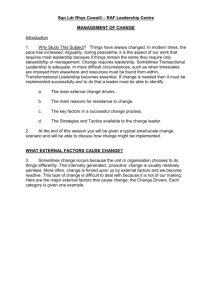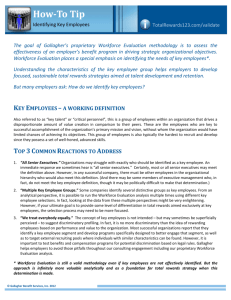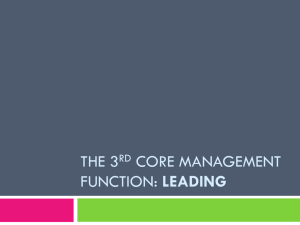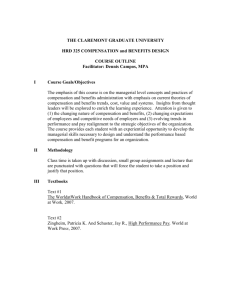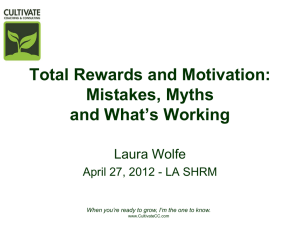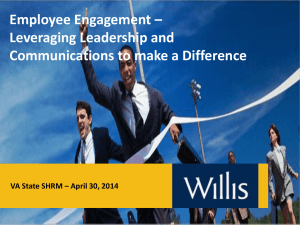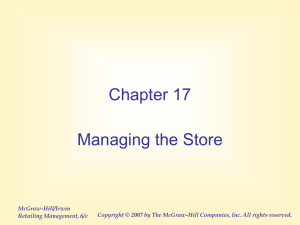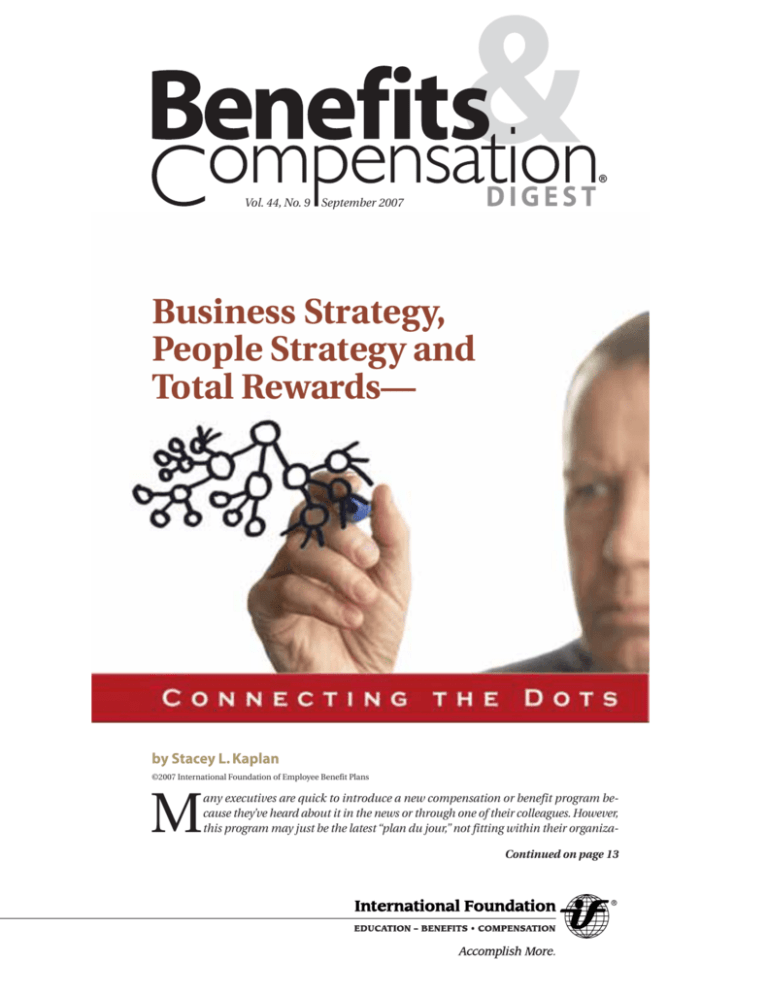
®
Vol. 44, No. 9 September 2007
Business Strategy,
People Strategy and
Total Rewards—
by Stacey L. Kaplan
©2007 International Foundation of Employee Benefit Plans
M
any executives are quick to introduce a new compensation or benefit program because they’ve heard about it in the news or through one of their colleagues. However,
this program may just be the latest “plan du jour,” not fitting within their organizaContinued on page 13
Business Strategy, People Strategy
Continued from page 1
Setting the Stage:
Understanding Your Business
There are many factors influencing the
formulation and execution of a sound
business strategy. When thinking about
strategy, one must look forward and visualize how the organization might evolve.
The strategy provides the “roadmap,” articulating the organization’s overall business direction. What is the mission of
your organization? A mission statement
describes its overall purpose—what you
do, who you do it for and how you do it.
Executives may labor
for hours drafting the most
articulate mission and vision
statements, but this exercise
alone will not drive the
organization forward.
ments, but this exercise alone will not
drive the organization forward. Other
critical questions must be asked and answered relating to customers, competition, culture and the company’s position
in its lifecycle.
Economics 101 taught us about the
typical business lifecycle of emergence,
growth, maturity and decline. Emerging
and growing companies execute their
strategies differently than mature companies or those in decline. It is important for
an organization to understand its current
position in its lifecycle and determine if it
wishes to compete in that position or
strive to change it. For example, banking
traditionally has been considered a mature industry; however, with other financial services companies offering competing services (e.g., insurance companies,
▼
Many human resources (HR) professionals aspire to forge a “strategic partnership” with their top management.
However, this expression appears diluted
upon observing HR executives buried in
“administrivia,” focused on operational
tactics rather than business outcomes.
For HR executives to play the esteemed
role of “strategic partner,” they must
demonstrate business knowledge. This
knowledge includes not only how a forprofit entity earns its money or, in the
case of a nonprofit, how it fulfills its mission, but also how it serves its customers
and differentiates itself from its competitors. Too often, that knowledge is lacking.
Top management will continue to exclude even the most experienced HR directors from boardroom discussions until
they exhibit financial literacy and business acumen. When HR professionals
demonstrate their understanding of what
is driving their business, they will add
value by mobilizing the right workforce
with the right skills to achieve the business goals of the enterprise.
credit unions), banks have revamped
their thinking, and some have changed
their business strategy to contend with a
new set of competitors.
Some organizations face the challenge
of managing businesses across multiple
lifecycles. Superior Energy Services, a
New Orleans-based provider of specialized oilfield services and equipment serving the oil and gas industry, encompasses
both mature and emerging business
units, resulting from several acquisitions
over the past few years.
According to Ray Lieber, vice president
of HR, “We’re required to tailor our business and people strategies to our business units, since our company is comprised of both growth-oriented and
mature business lines. Although we are a
growth company, some of our business
units have reached a more mature cycle
due to the nature of their services and
current geographic operating areas.”
In their writings about general business strategy, Benjamin Tregoe and John
Zimmerman from Kepner-Tregoe, Inc.,
identify “driving forces” that propel organizations to accomplish their goals
(see Table I). Although the authors name
nine possible driving forces, typically
only one or two serve as the basis for
business strategy, determining the types
of products and services offered and the
markets in which they are offered. For example, financial institutions and auto
manufacturers are product driven, committed to increasing the quantity and
quality of their products. Consumer
products and retail organizations are
driven by market needs. Organizations
that are technology driven focus on developing products and services that are
based on the latest technological advances. Production-driven companies focus on maximizing their production capacity, such as hospitals striving to fill
beds and airline carriers aiming to occupy seats. Knowledge of an organization’s key driving forces keeps it focused
on its path to execute its business strategy.
When companies formulate their
business strategy, they determine how
they intend to compete in the marketplace. Over 20 years ago, marketing guru
Michael Porter defined competitive strategy as “being different” and identified
COMPENSATION
tion’s strategic direction. It is important to
identify and implement programs that
bring an organization further along its
strategic path. This article strives to “connect
the dots” among business strategy, people
strategy and total rewards. It describes the
value of integrating these initiatives and the
value that a total rewards strategy brings in
the achievement of business goals. It presents a “how-to” approach in linking the
total rewards—defined as compensation,
benefits, learning and development, and
work environment—to an organization’s
business and people strategy.
What is your vision? Defining an organization’s vision requires forward thinking,
since it articulates the organization’s desired future.
Along with mission and vision are organizational values that describe what is
important to your organization and serve
as enablers to accomplishing its mission.
They may be qualitative (e.g., teamwork,
respect) or quantitative (e.g., dollars). The
mission, vision and values provide a
foundation for business strategy, but that
is just the beginning of the discussion, as
evidenced by the agenda of just about
every strategic planning session. Executives may labor for hours drafting the
most articulate mission and vision state-
Continued on next page
September 2007 • www.ifebp.org • Benefits & Compensation Digest
13
Table I
Driving Forces and Sample Organizations in Alignment
Driving Forces
Sample Organizations
Products offered
Financial services
Production capability
Health care
Market needs
Consumer products
Natural resources
Petroleum
Method of sale
Door-to-door sales
Method of distribution
Manufacturer’s representatives
Size/growth
Conglomerates
Technology
Scientific innovators
Return/profit
Portfolio companies
Source: Kepner-Tregoe and International Foundation of Employee Benefit
Plans.
Sample Questions to Ask Top Management
• What are your mission/vision/values?
• What are your current pressing business issues?
• What is your business strategy? Is it working?
• What are your strengths, weaknesses, opportunities and threats?
• What effect do your customers have on your business?
• What are your current workforce capabilities?
• What will your workforce requirements be in the future?
• How will you bridge the gap between current and future needs?
three ways in which an organization
might compete. These principles are still
valid today. Will they compete on price,
like Wal-Mart (e.g., be the low-cost
provider)? Will they try to differentiate
themselves based on products or services, like Nike? Will they segment the
market and focus on a particular group of
buyers or geographic area, like IKEA? Understanding the competition is a business
imperative. HR professionals are aware of
the competitive landscape from an attraction and retention standpoint but
would benefit from knowledge of their
competitive environment at large.
An initial step for HR to forge a strategic partnership with senior leadership is
to participate in open dialogue about the
organization’s business strategy along
with its short-term and long-term goals.
At left is a list of key questions to ask top
management to understand its current
and future business challenges. This is a
14
precursor to establishing a people strategy that defines the resources and capabilities required to execute the business
strategy. The answers to these questions
will provide a framework upon which to
develop a people strategy aligned with
the business strategy.
Solidifying Your
People Strategy
Once the business strategy has been
defined, top management and its subordinate leaders must execute the business
plan. A solid people strategy plays a critical role in moving the company forward
in attaining its goals. A people strategy—
or HR strategy—defines the resources required to execute the business strategy,
including the competencies needed to
support the objectives of the organization.
This definition relates to the classic phrase
“the right people with the right skills.” The
September 2007 • www.ifebp.org • Benefits & Compensation Digest
leadership team retains its responsibility
to define the requisite behaviors and skills
and to identify and bridge the gaps between the “as is” workforce and the “to be”
model.
Aligning people strategy with business
strategy affects how workers are deployed.
For example, Southwest Airlines builds its
business strategy around low operating
costs and stellar customer service. Its people-centric culture enables it to execute its
strategy. Southwest needs a workforce that
embraces customer friendliness and customer satisfaction, and the company recruits individuals who possess strong communications and customer-facing skills.
Regarding job design, Southwest embraces broader roles rather than narrowly
defined jobs to create a more flexible
workforce. The carrier empowers its workers to make decisions with considerable
freedom and responsibility. Worker flexibility, including the ability to demonstrate
skills across multiple job roles, facilitates
customer service.
Business events influence an organization’s people strategy and the composition of its workforce. Events such as
mergers, acquisitions, staff reductions,
plant closures and expansion into other
countries affect the organization’s talent
requirements. If a mature organization
acquires an emerging company whose
competencies lie in innovation and technology, the workforce requirements
change. Leaders must respond by recruiting and developing technically savvy
workers and determining how to keep
them engaged and productive. In the
case of global expansion, required skill
sets may change to execute the business
strategy in another country. This might
include the need for a bilingual workforce with an understanding of the culture and business mores abroad. To be
successful, attraction and retention policies need to be aligned with strategic
business goals.
When Sears, Roebuck and Co. embarked on a business transformation
about ten years ago, it aspired to become
a “compelling place to work, shop, and invest.” This slogan demonstrated alignment with its key stakeholders—employees, customers and shareholders. To
translate its business goals into reality, the
company educated its employees at all
Continued on page 16
Categories of Total Rewards and Sample Components
Table II
Compensation
Learning and
Development
Work Environment
Base salary
Health care
Career planning
Flexible workweek
Annual incentives
Life insurance
Succession planning
Telecommuting
Long-term cash incentives
Disability
Professional memberships
Job design
modifications
Equity (stock options,
restricted stock)
Retirement/401(k)
Training programs
Comfortable
workstations
Spot awards
Child-care resources
Annual conferences
Recognition
programs
Project incentives
Fitness center
Mentoring programs
Community
volunteer
opportunities
Employee referral program
Elder-care programs
Lunch and learns
Casual dress
Signing bonuses
Legal assistance
Sabbaticals
Free meals
levels on its business drivers to engage
them in implementing the retail business
strategy. Learning maps measuring six
feet were used to help employees visualize
services offered by the company and better understand their own role in improving competitiveness and business processes.
NewPage Corporation, an Ohio-based
manufacturer of coated papers, believes
in communicating its business goals to its
workforce of over 4,000 employees. According to Glenn Grill, director of compensation and benefits, “We’ve begun the
process of educating our workforce on our
goals and business model. Both union and
nonunion employees have been exposed
to our organization’s key business objectives in areas such as financial metrics,
lean Six Sigma, customer service and productivity initiatives.”
Total Rewards—
Aligning With Business Strategy
and People Strategy
Total rewards encompass everything
that employees value in their employment
relationship—compensation, benefits, development and the work environment. It
is a holistic approach that aligns with
business strategy and people strategy. In
the last decade, employers realized that
they must go beyond just offering competitive compensation and benefits programs (transactional rewards) to compete
for talent. This is especially true today
16
Benefits
where loyalty of the emerging workforce’s
members is more to themselves than to
their employers.
Compensation and benefits programs
are typically financial in nature and must
be at least at a baseline competitive level
for companies to attract and retain talent.
Competitors easily copy these programs,
which typically fail to engage employees
enough to stay with an organization.
Learning and development programs and
a flexible and fun work environment (relational rewards), however, provide an opportunity for employers to better differentiate themselves from their competition
and enhance employee commitment to
their organization. All four components of
rewards encompass a tool kit for HR leaders to draw upon in constructing a comprehensive rewards program that will provide them a competitive edge. Table II
identifies samples of rewards in each of
the four categories.
Many employers on Fortune magazine’s annual list of the best companies
to work for in America embrace a total
rewards strategy rich in relational rewards, such as flexible working arrangements, developmental opportunities and
fun office perks. This strategy provides
them heightened visibility as a preferred
employer in a tight labor market. Research has shown that higher-rated employers tend to receive more employment applications, making recruitment
easier. Additionally, these higher ratings
often translate into improved retention
September 2007 • www.ifebp.org • Benefits & Compensation Digest
and enhanced profitability, since engaged employees typically provide better
customer service.
Google achieved Fortune magazine’s
coveted number one position on its list of
the best companies to work for in 2007.
No one can dispute Google’s remarkable
business performance. What is interesting
to note is its incredible mix of quirky and
traditional employee perquisites. One can
reasonably deduce that its people strategy
is to drive productivity by attracting high
achievers who are willing to spend most of
their time at work. Its complementary reward strategy is to provide amenities that
enable employees to manage their lives
more easily while maintaining focus on
their jobs. Sample perks include company-paid gourmet meals, a 24-hour gym,
an in-house doctor and concierge services
like dry cleaning and on-site massages.
This strategy makes employees feel valued
and enhances the attraction and retention
of talent that is committed to helping the
company execute its business strategy, regardless of the blur between personal and
work lives.
Volkswagen of America aligns its financial rewards to its business by paying
incentives for the attainment of individual goals related to the achievement of
shared company goals. All employees are
eligible for bonuses.
“Our shared critical targets in areas
such as sales, customer and dealer satisfaction, and profitability are aligned both
top down and across business units to
promote positive employee relations.
Aligning these strategies enhances the
likelihood that the retailer’s business
goals will be attained.
Rewards programs are best designed
and implemented after the successful
alignment of an employer’s business
strategy and people strategy, as opposed
to selecting program components in a
vacuum. Too often organizations jump to
the implementation phase without assessing the impact on the business and
people strategies. This results in solutions that are out of sync with their business challenges. There may be trendy solutions written up in the latest trade
journals, but they may not be appropriate solutions for every company.
be counterproductive in an environment
that emphasizes collaboration and team
performance, unless they are well integrated with overall company goal attainment.
An organization’s stage in its lifecycle
influences its people strategy and where
to place its bets from a total rewards perspective.
“Our emerging business lines have different needs than in our more mature
units,” Lieber said. “In terms of rewards,
one size definitely does not fit all. We are
attempting to design and pilot some nontraditional pay initiatives in our growth
companies, while ensuring that employee
development programs are structured as
a complementary element of the total
strategy.”
The Power of Alignment:
Connecting the Dots
For example, when broadbanding was
first introduced as a new, flexible approach to salary administration, some
business magazines wrote about it, highlighting the advantages of fewer, wider
salary ranges and perceived streamlined
administration. Some organizations were
quick to implement this approach without
considering the amount of manager education and monitoring needed to be costeffective. Although a very workable solution for many organizations, it was not a
good fit for others.
Similarly, reward programs need to
be selected that complement the organization’s values and culture. If teamwork
is a key value, then reward programs
should reinforce teamwork versus individual performance. Incentive programs
that reward individual achievement will
▼
Aligning business strategy,
people strategy and total
rewards requires education,
communication and
commitment of business
leaders and their teams.
What does the alignment of business
strategy, people strategy and rewards
look like? Imagine this scenario: HR
demonstrates its business acumen and is
invited into the boardroom to participate in strategic business discussions. A
credible strategic partnership emerges
between senior management and HR.
With a solid understanding of the business, HR positions itself to develop and
execute its people strategy, bridging the
gap between current workforce capabilities and future required capabilities essential for organizational goal attainment. HR serves as a catalyst to energize
the workforce, understanding the employee value drivers important for attracting and retaining the right talent to
execute the business plan. HR analyzes
the workforce demographics to understand the composition of the workforce
and changing needs. The results challenge HR to rethink the total rewards
package.
Baby boomer retirements are proliferating, and strong-willed Generation Yers
require different types of rewards. The
emerging workforce values flexibility, opportunities to work on the latest technology and immediate recognition for performing well. HR designs a mix of
transactional and relational rewards, balancing a competitive compensation and
benefits package with innovative learning
COMPENSATION
promote teamwork and organizational
performance,” said Lynda Gugel, general
manager of HR.
The company’s development programs also support the achievement of
business results.
“We invest in learning and development solutions that align competencies
and behaviors with business outcomes
that most closely support our business
strategy,” Gugel said.
Table III highlights the alignment of
business strategy, people strategy and total rewards for a retail chain that wants to
increase its revenue and profits and embraces superior customer service as part
of its business strategy. It scrutinizes its
policies and changes some of them to reflect a more customer-centric approach,
such as liberalized return policies and expanded store hours. The retailer develops
a people strategy to facilitate its goal attainment. One of the key provisions is to
attract and hire store associates who are
actual customers of this retail chain. The
idea is to translate customer loyalty into
associate loyalty by capitalizing on the
positive feelings the customer already has
for the retailer and its brand. A second
provision within its people strategy is to
staff the store for peak periods, utilizing
part-time associates to cover periods of
heaviest traffic volume. Third, the retailer
strives to enhance the selling skills and
competencies of its sales force.
The retailer designs its rewards strategy to align with its business and people
strategy. The retailer decides to provide a
base salary and benefits package at the
“going rate” in the community. Besides
providing competitive pay and benefits,
it offers a storewide incentive plan to reward team performance, with one of the
metrics being customer satisfaction
scores obtained from a storewide survey.
The retailer offers flexible work arrangements to associates who desire a parttime work schedule. It taps into retirees
and students to help cover peak periods
in the evenings and on weekends. In line
with its people strategy to develop its
workforce, it offers sales training classes
to enhance employees’ product knowledge and sales skills. In turn, a bettertrained workforce enhances customer
service, one of the retailer’s primary business strategies. The retailer offers an employee discount to encourage associates
to continue shopping in the stores and
Continued on next page
September 2007 • www.ifebp.org • Benefits & Compensation Digest
17
Table III
Sample Linkage of Business Strategy, People Strategy and Total Rewards
Business Strategy
People Strategy
Total Rewards Strategy
Provide superior
customer service.
Hire current customers.
Pay going-rate base salaries and benefits;
provide team-based incentives and employee discount.
Keep stores open
when customers want
to shop (e.g., later
hours, weekends).
Increase part-time
workforce to cover
peak periods.
Provide flexible work arrangements,
including more part-time schedules.
Offer unique products
at reasonable prices.
Hire inexperienced
Provide sales training
employees, and provide
and product knowledge training.
development opportunities.
Table IV
Five Steps to Aligning Total Rewards With Business and People Strategies
Develop Business
Strategy
Align People
Strategy
Align Total
Rewards
Assess Financial
Impact
Implement
and Monitor
• Mission/vision/values
• “As is” vs. “to be”
capabilities
• Compensation
• Cost/benefit
analysis
• Administrative
policies
• Business lifecycle
• Workforce
demographics
• Benefits
• Cost sharing
• Training
• Driving forces
• Employee value
drivers
• Development
• Return on
investment (ROI)
• Program audit
• Competitive strategies
• Attraction and
retention ideas
• Work
environment
• Future workforce
changes
• Followup
Source: International Foundation Certificate Series: Total Compensation and Organizational Strategies.
and work environment amenities. The offering tries to differentiate the company
from its competitors—perhaps with specialized training, spot bonuses, workout
facilities or perks that will make employees’ busy lives a bit easier. It may even find
a way to engage the employees in socially
responsible activities, like community service or “green” environmental issues,
which resonate well with young workers.
HR analyzes the financial impact of
developing its total rewards strategy and
the associated program costs. Once implemented, HR monitors ongoing administration, making modifications as
needed to ensure that the programs retain their cost-effectiveness and continue
to accomplish their prescribed goals.
Table IV summarizes five steps toward
aligning total rewards with business and
people strategies.
Aligning business strategy, people strategy and total rewards requires education,
18
References
Durfey, Kelly. “Aligning Employees to Organizational Objectives,” Solutions. June 2002:26-28.
Kaplan, Stacey. “Total Rewards in Action: Developing a Total Rewards Strategy,” Benefits &
Compensation Digest. August 2005:32-37.
Kaplan, Stacey and Larry Montan. Total Compensation and Organizational Strategies curriculum. International Foundation 2007.
Kiger, Patrick J. “HR’s New Strategic Role,”
Workforce Management Online. September 2006.
Nichols, Fred. Strategy—Definitions and
Meanings. Educational Testing Service 2006.
“Perk Place: The Benefits Offered by Google
and Others May Be Grand, but They’re All Business,” Knowledge@Wharton. March 21, 2007.
Porter, Michael. Competitive Strategy. Harvard
Business School Press; 1986.
Porter, Michael. “What Is Strategy?” Harvard
Business Review. November-December 1996.
Sherman, Stratford and Anthony Rucci.
“Bringing Sears into the New World,” Fortune.
October 13, 1997. CNNMoney.com.
Singh, Ph.D., Parbudyal. “Strategic Reward
Systems at Southwest Airlines,” Compensation &
Benefits Review. March/April 2002:28-33.
Tregoe, Benjamin and John Zimmerman. Top
Management Strategy. Simon and Schuster 1980.
“Broad Focus Needed to Ensure HR Strategy
and Business Strategy Work Together” WorldatWork online newsletter. May 8, 2007.
For information on ordering reprints of
this article, call (888) 334-3327, option 4.
communication and commitment of business leaders and their teams. Through regular two-way communication efforts, department managers and supervisors
educate their teams on business operations and their critical role in achieving the
business plan. Inherent in this process is
managing the change that will likely ensue
from greater performance expectations
and accountability. Through its people
strategy development and total rewards
design, HR serves as a change agent, helping to connect the dots to reveal a picture
of workforce synergy, with everyone focused on the attainment of common business goals. Successful execution demonstrates the power of alignment.
B&C
September 2007 • www.ifebp.org • Benefits & Compensation Digest
[
Stacey L. Kaplan is the managing principal of Diamond
Consulting Group LLC, an independent HR consulting
practice located in West Bloomfield, Michigan. She specializes in total reward, performance management and
general HR consulting. Kaplan holds a bachelor’s degree
from Tufts University and a master’s degree from Central
Michigan University, as well as the certified compensation
professional designation. She is an instructor for Total
Compensation and Organizational Strategies, an International Foundation Certificate Series course.
E-mail address: Stacey.Kaplan@diamond-consultinggroup.com
[
COMPENSATION
Reproduced with permission from Benefits & Compensation Digest, Volume 44, No. 9,
September 2007, pages 1, 13-19, published by the International Foundation of Employee Benefit Plans (www.ifebp.org), Brookfield, Wis. Statements or opinions expressed in this article are those of the authors and do not necessarily represent the
views or positions of the International Foundation, its officers, directors or staff. All
rights reserved.
▼
September 2007 • www.ifebp.org • Benefits & Compensation Digest
19

